Singapore has a rich multicultural history with people from China, India, Malaysia and other Asian countries living in perfect harmony. About ten percent of the entire population of Singapore are Indians, most of whom follow Hinduism and this is the reason why you will find dozens of Hindu temples in different corners of the island. Since most of the Indians who migrated to Singapore are from the southern Indian states, the temples here reflect the typical South Indian architecture with large gopurams, ornate carvings and bright colors emanating from throughout the interior of the sanctuary. Like Hindu temples in other countries outside of India, Singapore temples also promote rich Indian culture by hosting festivals, music and dance concerts, and other large-scale religious events. . It goes without saying that these temples also act as a bridge connecting people living in foreign countries with their roots in India. If you are traveling to Singapore and want to explore the Hindu temples of this island country, here are the 15 best temples that should definitely be on your travel itineraries.
1) Sri Mariamman Temple:
Singapore’s oldest and most revered Hindu temple built in 1827, the “Sri Mariamman Temple” is located in bustling Chinatown and is visited daily by hordes of pilgrims and tourists. Built-in the style of pure Dravidian architecture with a slender gopuram decorated with intricate carvings of figurines and deities associated with Hindu mythology painted in bright colors, the temple can be seen even from afar. Dedicated to the goddess Mariamman, believed to protect her devotees from disease, the temple holds great religious significance in the hearts of the Hindu and Tamil inhabitants of Singapore. In addition to housing the shrine of the presiding goddess Mariamman, the temple also houses the shrine of the goddess Draupadi, who is honored during the annual Thimithi festival which takes place in October / November. During this festival, devotees walk barefoot along the burning coal tracks to fulfill their wishes, bringing a great display of faith, courage and endurance to all onlookers. The interiors of the temple are as colorful as the exterior with brightly colored walls and ceilings, decorated with exquisite patterns and frescoes. The independent shrines of Lord Rama, Murugan, Goddess Durga, Lord Shiva and Lord Ganesha can also be seen in the temple.
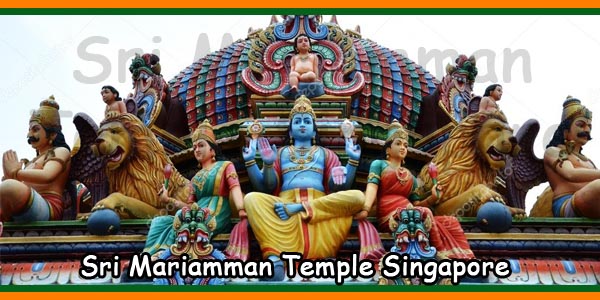
Built-in colonial times, the Sri Mariamman Temple was the only temple in Singapore allowed to perform Hindu weddings. Even today, traditional Hindu wedding ceremonies continue to take place in the temple. Since its inception, the temple has also served as a refuge for many immigrants, providing them with shelter and food until they find work or accommodation for themselves. Even today, this temple works significantly for social, cultural and educational causes for the Hindu community living in the country.
2) Sri Veeramakaliamman Temple:
Located in the heart of Little India, on the always busy Serangoon Road, the “Sri Veeramakaliamman Temple” is another of Singapore’s most beautiful, famous and revered Hindu temples. Dedicated to the goddess Kali, the destroyer of evil, the temple is one of the oldest in the country and was built by a group of migrant workers from the Bengal and Tamil Nadu regions of India to Singapore during the year 1881. The architectural style of the temple resembles the characteristic style of South India, adorning the magnificent gopuram decorated with brightly colored carvings of Hindu mythological figures, which is sure to leave you in awe as soon as you lay eyes on it. . When you enter the temple premises, you will find the goddess standing in her normal ferocious form, with the garland of skulls and a bowl of blood. A more serene idol of the goddess in the temple facilities, feeding her family, shows her more placid and motherly side, blessing the devotees.

For those who wish to seek the blessings of the goddess, they can visit the temple at any time of the day except between 1:00 p.m. and 4:00 p.m. Photography is also allowed inside the temple, but be careful not to disturb people praying and obey the rules of removing your shoes and dressing modestly before entering.
3) Sri Srinivasa Perumal Temple:
Another more popular Hindu temple in Singapore is the “Sri Srinivasa Perumal Temple”. Dedicated to Lord Perumal (Krishna), an incarnation of Lord Vishnu, the temple dates back to 1855 and again reflects a Dravidian architectural style. The five-level gopuram of the temple rises to a height of 20 meters and is adorned with beautiful carvings and carvings of Lord Vishnu in his various manifestations. Inside the temple, in the main shrine, you will find the deities of Vishnu, his wives Lakshmi and Andal and their bird carrier, Garuda. The temple courtyard houses a well once thought to be a stream that served as an important source for worshipers to ritually purify themselves before beginning prayers.

The temple is now the main venue for the annual Thaipusam festival which honors the Hindu god Murugan. During the festival, a large procession, carrying the chariot of Lord Murugan, is led by ardent devotees with metal skewered piercings on the cheeks or tongue and Kavadis adorned with peacock feathers and flowers balanced on their shoulders. . Ending at the “Thendayuthapani Temple”, located on Tank Road, the festival often stops traffic in Singapore, providing a great spectacle for all spectators. If you are in Singapore during the festival, be sure to visit the temple and take a look at the unusual Hindu customs and traditions.
4) Sri Thendayuthapani Temple:
Situated in a picturesque and peaceful setting near the river valley on Tank Road, the “Sri Thendayuthapani Temple” is another most important religious site for Hindus in Singapore and attracts hundreds of devotees and tourists every day. Founded in 1859 by the “Nattukkottai Chettiars” community (a Tamil community that believes in the Shaivism system) in Singapore, the temple is also popular as a Chettiar temple. The temple’s architecture is largely South Indian in style, and its imposing 75-foot five-level gopuram with ornate deities welcomes everyone. The interior hallways of the temple are as exquisite as the exterior and are supported by richly carved pillars adorned with various mythological figures. Although the presiding deity of the temple is the Hindu god Murugan, the temple also enshrines the shrines of Lord Sundareswarar, an incarnation of Lord Shiva, the goddess Meenakshi, an incarnation of the goddess Parvati, and Navagraha (nine deities with each associated with a planet). One of the oldest Murugan temples in Singapore, this temple is a must-see for anyone with a penchant for religion and spirituality.
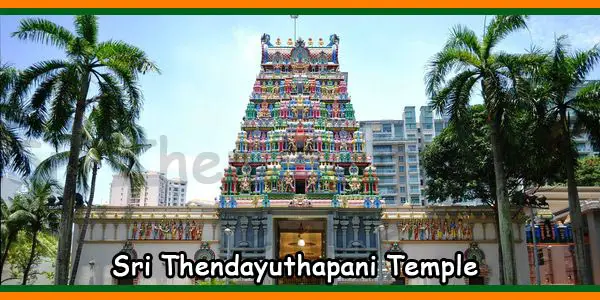
The annual Thaipusam festival is also a big event at the “Sri Thendayuthapani Temple” which invites hordes of devotees to be part of the festivities. On the eve of the festival, devotees carry the statue of Murugan, placed on a silver chariot, to the “Layan Sithi Vinayagar Temple” and return at night. The second day of the festival is much grander and offers a magnificent view of devotees leading a procession from the Srinivasa Perumal temple to the Thendayuthapani temple. During the procession, the sight of many men piercing large metal skewers on the tongue, chest and other parts of the body to implore Murugan’s help or as a thank you for answered prayers, can often be seen in walking and dancing, offering an unusual spectacle. show.
5) Sri Layan Sithi Vinayagar Temple:
Another most important and popular Hindu temple in Singapore is the “Layan Sithi Vinayagar Temple“, located on Keong Saik Road in Chinatown. Dedicated to Lord Ganesha, brother of Lord Murugan, this temple was also built by the Chettiar community in Singapore during the year 1925. Like other South Indian temples in the country, the Layan Sithi Vinayagar temple will also amaze you with its beautiful architecture. and vibrant colors oozing from its imposing gopuram. The main shrine houses the presiding deity of Lord Vinayagar (Ganesha) as well as a Vel Santo (lance) symbolizing Lord Murugan and is visited by hundreds of devotees of all races throughout the day. Between Thursday and Sunday, many worshipers can be seen circling the main shrine 108 times to fulfill their vows. The temple also sees a large influx of pilgrims, worshipers and tourists on the eve of the annual Thaipusam festival when Lord Murugan comes to visit his brother, Ganesha in a silver chariot from the “Sri Thendayuthapani Temple”. The holy vel found in this temple is brought to the “Thendayuthapani temple” for the Thaipusam festival and poured with the milk offered by the devotees.

If you happen to be passing through the busy streets of Chinatown, visit this temple for a while and immerse yourself in the peace and serenity offered by its tranquil atmosphere.
6) Sri Senpaga Vinayagar Temple:
Over 150 years old, the “Senpaga Vinayagar Temple” was first consecrated in 1850 after the discovery of an idol of Lord Vinayagar in the shade of a Senpaga tree next to a pond. At that time, only a small shelter was built around the tree and the deity was enshrined in this structure. Today, the temple located on Ceylon Road features a captivating architectural design based on the lines of Chola architecture found in southern India with a heavenly ornate gopuram, but not as vibrant as other temples in the country, which gives it a more subtle look. The interior of the temple houses the sanctum sanctorum dedicated to Lord Ganesha with its vaulted ceiling, plated with pure gold. The four pillars of the prayer hall adorn 32 Vinayagar granite sculptures in their various forms, offering you a magnificent spectacle. The temple’s ceiling decorated with exquisite frescoes depicting scenes from Hindu mythology also instantly captures your visual senses.
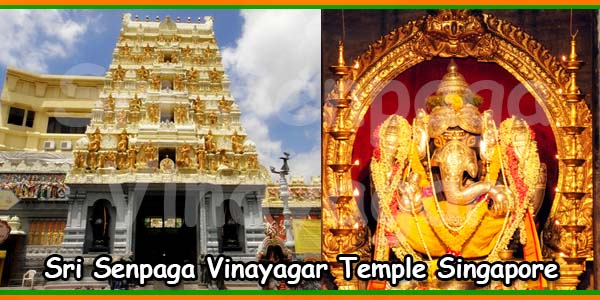
The second oldest Hindu temple in Singapore and also one of the country’s most revered Vinayagar temples, the “Senpaga Vinayagar Temple” receives thousands of visitors each year. Unlike other Hindu temples in Singapore which were built by Tamil Indians who migrated to the country from parts of southern India, this temple identifies strongly with the Ceylon community or with the Tamils who migrated to Singapore from Sri Lanka.
The richly decorated architecture, the tranquil atmosphere and the aura filled with spirituality make this religious site a must-visit on your trip to Singapore.
7) Sri Sivan Temple:

Located in the Geylang district of Singapore, the “Sri Sivan Temple” is dedicated to Lord Shiva and is one of the most beautiful Hindu temples in the country with beautiful octagonal-shaped architecture which is a blend of northern and northern design styles. southern India. Carrying great religious significance in the hearts of all Hindus residing in the country, the temple sees hundreds of devotees pass by every day who come here to offer their prayers and seek the blessings of god. In addition to local Singaporeans, the temple is also a major attraction for foreign tourists, who flock here to gain insight into Hindu customs and traditions. For those looking for an unforgettable Sivan temple experience, they must visit here during the Maha Shivratri festival when the temple is at its best, bathed in the light of thousands of bulbs and filled with flocks of devotees awaiting their turn to bathe the saint. Shivlinga with milk. During the festival, many cultural programs are also held at the temple premises throughout the night, providing an unparalleled opportunity for photography fans and those with a penchant for learning new cultures to have a good time. gala. By far one of the best spiritual places for Hindus in Singapore, you can’t miss it while on vacation in the country.
8) Sree Maha Mariamman Temple:
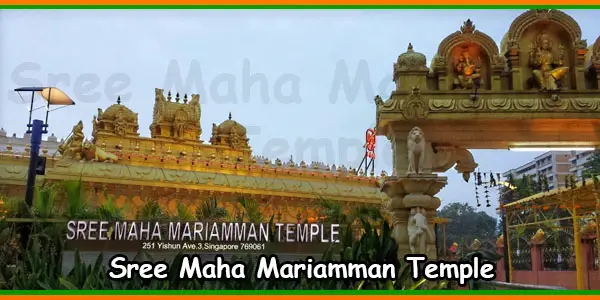
The history of “Sree Maha Mariamman Temple” dates back some 85 years when Hindu workers from the Sembawang Rubber Estate built a small shrine dedicated to Sree Maha Mariamman in the form of cement idol. Between 1950 and 1960, the temple was moved from its original location to Mandai Road, and the cement idol of the goddess was replaced by the granite statue. During the dedication ceremony, the idols of Sree Sivan, Sree Krishna, Sree Vinayagar and Sree Murugan were also enshrined in the temple. In 1996, the temple site was acquired by the Urban Redevelopment Authority and it was then that the temple management committee found the permanent home of the goddess Maha Mariamman in Yishun, where it is currently located. Today, the temple is also home to the Sree Nagar, Sree Saneeswarar and Navagraha shrines. The architecture of the temple with its golden roof adorning the 16 manifestations of the goddess Mariamman instantly captivates your senses. The interiors of the temple also provide an unparalleled visual spectacle with beautifully carved statues and sculptures adorning the walls and ceilings of the temple. If you are looking for temple architecture that offers something unique compared to the usual Dravidian temples; The “Maha Mariamman Temple” is a perfect visit to Singapore.
9) Holy Tree Sri Balasubramaniar Temple:
The history of Balasubramaniar Temple located in Yishun Industrial Park has an interesting history dating back around 50 years when the area was used as a shipyard by the British Royal Navy. It is said that on the eve of Pongal, a shipyard worker dreamed of Lord Murugan and a golden cobra sitting under an Elanthamaran (Chinese red date) tree in a swampy mangrove forest somewhere around the Canberra highway. The worker went to look and found the particular tree with six main branches symbolizing the six arms of Lord Murugan. He enshrined the images of Lord Murugan and a large Vel under the tree. Soon the small shrine gained popularity and a temple was built around the tree, which later became known as the Balasubramaniar temple of the “sacred tree”. Today, the temple is one of the most popular Hindu temples in Singapore, attracting hundreds of worshipers every day. There is great excitement in the temple during the annual “Panguni Uthiram” festival which takes place in March-April, inviting people from different corners of the country to be part of its grand festivities. During the festival, Lord Murugan’s idol is carried on a silver chariot as part of a grand procession that takes place along Sembawang Road, along Canberra Link and finally ends at Balasubramaniar temple; a stretch of nearly 2 kilometers. Similar to Thaipusam, the Panguni Uthiram procession also sees a large number of devotees carrying Kavadis on their shoulders or tied to their bodies. Many devotees can also be seen carrying pots of milk on their heads to offer them to the god.
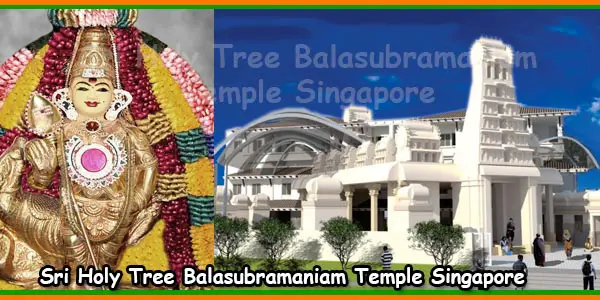
If you get the chance, visit this historic temple on your visit to Singapore, and if you’re lucky you might even be lucky enough to be a part of the colorful Panguni Uthiram festival.
10) Sri Vadapathira Kaliamman Temple:
Another famous Hindu temple in Singapore located at the junction of the Balestier and Serangoon roads near Little India, the “Vadapathira Kaliamman temple” is said to have been founded in 1830 by a single devotee by placing the image of the goddess Kali under the banyan tree. . which was once located near the present temple. As the small altar gained popularity among the Hindu community, it became a full-fledged temple in 1935. In addition to housing, the shrine of the presiding deity of the goddess Kali, the temple is also home to many statues of other gods. and goddesses, the most important of which are Sri Hanuman, Sri Vinayagar, Sri Ramar, Sri Nageshwari Amman and Sri Periyachi Amman.

With great religious significance in the hearts of Singaporeans, the temple attracts large numbers of devotees and tourists every day who come here to worship and seek the blessings of the god. Tuesdays and Fridays are the days when you will find many pregnant women flocking to the temple in search of the blessings of Periyachi Amman, a manifestation of the goddess Kali, who is believed to protect the expectant mother and child in her womb from evil eyes. A special Periyachi Pooja is also performed at the large-scale temple during the Tamil month of Aadi, which is attended by large numbers of devotees.
One of the oldest and most important Hindu temples in the region, the “Vadapathira Kaliamman Temple” is also one of the city’s biggest attractions during the Deepavali festival. Richly decorated with thousands of lights and shining with its magnificent splendor, the temple offers everyone an incomparable visual pleasure. So, if you are in Singapore during the Festival of Lights, don’t forget to visit the temple and be captivated by its magical aura.
11) Sri Krishnan Temple:
Located on Waterloo Street in central Singapore is the magnificent “Sri Krishnan Temple” with its blue facade adorning the sculptures of 10 incarnations of Lord Vishnu. The front door is guarded by two impressive statues of Lord Hanuman and Garuda, on both sides. Built-in the pure architectural style of South India, Sri Krishnan Temple is the only temple in Singapore dedicated to Lord Krishna and his wife, the goddess Rukmini.
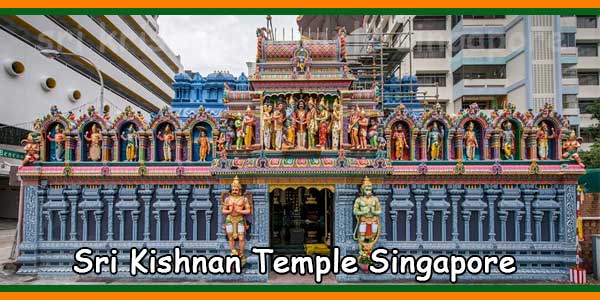
The history of the temple dates back to 1870 when a person named Hanuman Beem Singh enshrined an idol of Sri Krishna under a banyan tree on Waterloo Street, a central location for the Hindu community residing in the Bras Basah Road areas, Victoria. Rue and rue Albert. As the number of people gathering to worship at the temple increased, a suitable temple was built around the tree, the construction of which was completed in 1933. Since then, the temple has undergone many expansions and successive developments. This temple is also a great testament to the cultural and religious harmony of the people of Singapore, as many Chinese devotees of the nearby “Kwan Im Thong Hood Cho Temple” can often be seen passing by to light incense and pay your respect. . to the Lord. Krishna. The nearby Bugis Street is an added bonus for visitors who, after offering their prayers at the temple, can spend time shopping and gorging on delicious street snacks.
If you are in Singapore during Krishna Janmashtmi’s time, stop at this temple to witness the hustle and bustle and vitality filling the air.
12) Sri Ramar Temple:

Located on Changi Village Road on the east coast of Singapore, the “Sri Ramar Temple” is dedicated to Lord Rama. One of the very popular Vaishnavite temples in Singapore, it is visited by dozens of devotees every day, especially from the neighboring areas of Tampines, Pasir Ris and Simei. Speaking of the history of the temple, it started out as a small shrine with the deity of Lord Rama in the shade of a tree at its present site. Hindus from the nearby village began to flock to the shrine for daily prayers and offerings, and as the congregation grew, the small shrine became a more formal temple thanks to the efforts of Mr. Ram Naidu, an official of the British Indian Army of the time. Today, the temple not only consecrates the deity of Lord Rama, but also houses the statues of Lord Buddha and Quan Yin (Chinese Goddess of Mercy), which is why it is also aimed at non-Hindu devotees who attend churches here. God. A large and impressive statue of Lord Hanuman is the highlight of the temple, which is sure to amaze you as soon as you see it.
If you are in the Changi Village area during the Ram Navami or Hanuman Jayanti festivals, try to visit this magnificent site and immerse your souls in total serenity and tranquility. As the location of Sri Ramar Temple is close to Changi Beach, a visit here also allows you to have a pleasant evening strolling or relaxing on the soft sands.
13) Sri Murugan Hill Temple:
Located on Upper Bukit Timah Road in Singapore, it is another important Murugan shrine known as “Sri Murugan Hill Temple“. The beautiful and colorful architecture of the temple on top of a small hill captures your heart as you pass the road. The temple’s history dates back to 1960 when a plumber working in the area discovered a small shrine similar to Lord Muneeswaran’s on top of the hill. He began to pray in the shrine and quickly gained popularity. After a few months, due to the spread of fire in and around the shrine area, the prayers stopped and the shrine was abandoned. It was after the appearance of Lord Murugan in the dreams of the plumber, asking him to revive the temple and offer prayers as usual, the temple was restored with the deity of Lord Murugan with his wives, Valli and Deviani enshrined in it and in the temple. be called “Sri Murugan Hill Temple”. Today the temple is one of the most important Hindu temples in Singapore, visited by both locals and tourists. The hilltop location adds to its quaint charm.
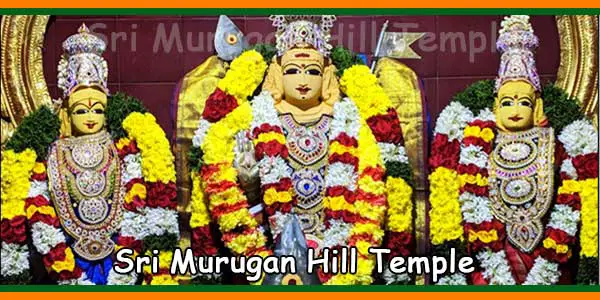
As in other temples of Murugan, the Thaipusam and Panguni Uthiram festivals in the hill temple are also celebrated with great fervor and joy by all devotees. The annual chariot festival which takes place in March-April also sees large numbers of people flock to the temple.
14) Arulmigu Velmurugan Gnana Muneeswarar Temple:
A very recent addition to Singapore’s religious scene is the magnificent “Arulmigu Velmurugan Gnana Muneeswarar Temple”, located right next to the Taoist Temple and Prayer Hall in the Sengkang area. Officially dedicated in February 2006, the temple is the first Hindu temple established with financial support from the Buddhist community. The presiding deities of the temple are Lord Vinayagar, Lord Murugan, Lord Muneeswarar and all the festivals related to the three main gods of the temple are celebrated with great zeal and enthusiasm. One of Singapore’s most popular temples, it is visited by devotees of all races, whether Hindus, Buddhists or Taoists. The temple architecture features a unique blend of modern design imbued with all the essential symbolisms of ancient South Indian temple architecture. The interiors of the temple which adorn the ornamental carvings on its pillars, walls and ceilings, also provide visual delight to visitors. If you love to capture the exquisite architecture of Hindu temples, this is a perfect place to be in Singapore.
15)Shree Lakshmi Narayan Temple:
The only temple serving the North Indian Hindu community in Singapore is the famous “Lakshmi Narayan Temple” located on Chander Road in Little India. Founded in 1969, the temple not only serves as a place of worship but also provides an environment for people to interact and participate in its various cultural events. Unlike South Indian-style temples, the architecture of this temple is quite simple and straightforward, with no towering gopurams or intricate carvings on the walls and ceilings. The main hall of the temple houses the deities of various Hindu gods and goddesses. The prayer hall inside is where the temple committee holds frequent Havans, Bhajans, and Kirtans on different occasions. The temple is packed with crowds during the Navratri and Deepavali festivals which take place here on a large scale.
For those looking to get an insight into the cultures and traditions of North India, they can definitely visit Lakshmi Narayan Temple in Singapore.
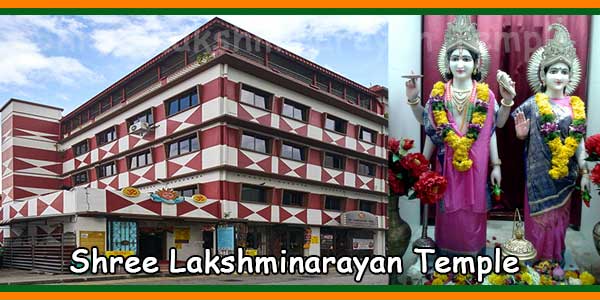
In addition to the temples listed above, there are many other small temples around the country that can be explored depending on your time and interests. Also, when visiting a Hindu temple, be sure to follow certain rules, such as removing your shoes before entering the shrine and dressing conservatively (although Singaporeans are generally quite open-minded about Most forms of clothing, they wear short, plunging blouses (necklines or miniskirts is definitely a big ‘NO’). Photography is generally allowed in temples, but it is always recommended to consult the guidelines. Considering these little details, you can surely have a wonderful time exploring the magnificent Hindu temples of the country.
